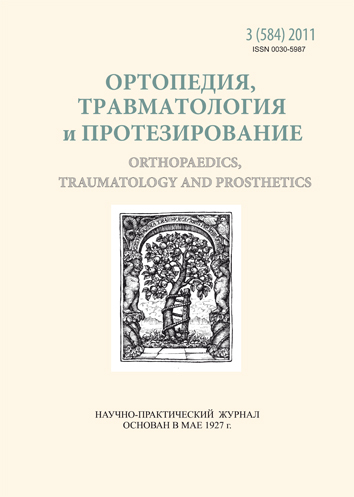Cell adhesion on biomaterial surfaces with nanocomposite oxide coatings
DOI:
https://doi.org/10.15674/0030-59872011384-87Keywords:
cell adhesion, biomaterial surfaces, nanocomposite oxide coatingsngsAbstract
Nanocomposite coatings, based on aluminium, zirconium and titanium oxides, have unique properties: high inductivity, density, biological and chemical inertness. These properties are very important for subsequent use of the above coatings as implants and scaffolds in tissue engineering. Surfaces with a nanocomposite oxide coating demonstrate their high electrical inertness and dielectric constants. Biological approbation of modern nanocomposite materials and coatings as promising biomaterials makes it possible to suggest principally new methods for treating many severe diseases.References
- Nanocomposite oxide and nitride hard coating produced by pulse magnetron sputtering H. Klostermann, B. Bacher, F. Fietzke et al. // Surface&Coating Tech. — 2005. — Vol. 200. — P. 760–764.
- Direct current magnetron sputtering deposition of nanocomposite alumina-zirconia thin films / D.H. Trinh, T. Kubart, T. Nyberg et al. // Thin Solid Films. — 2008. — Vol. 516. — P. 8352–8358.
- S180 cell growth on low energy plasma treated TiO2 thin films / M. Dhayal, S.I. Cho, J.Y. Moon et al. // J. Applied Surface Sci. —
- — Vol. 254. — P. 3331–3338.
- Interactions between cells and titanium surfaces / E. Eisenbarth, D. Velten, K. Schenk-Meuser et al. // Biomolecular Engineering. — 2002. — Vol. 19. — P. 243–249.
- Physico-Chemistry and Cytotoxicity of Ceramics / L. Dion, F. Bordenave, R. Lefevre, C.V. Boreille // J. Materials Science: Materials in Medicine. — 1994. — P. 18–24.
- Mechanical Properties, Phase Stability, and Bio-compatibility of (Y, Nb)-TZP/Al(2)O(3) Composit Abutments for Dental Implant / D.J. Kim, M.H. Lee, D.Y. Lee, J.S. Han // J. Biomedical Materials Research. — 2000. — Vol. 53. — P. 438–443.
- Ratner B.D. New Ideas in Biomaterials Science–A Path to Engineered Biomaterials / B.D. Ratner // J. Biomedical Materials Research. — 1993. — Vol. 27. — P. 837–850.
- Preparation of TiO(2) Layers on Cp-Ti and Ti6Al4V by Thermal and Anodic Oxidation and by Sol-gel Coating Techniques and Their Characterization / D. Velten, V. Biehl, F. Aubertin et al. // J. Biomedical Materials Research. — 2002. — Vol. 59. — P. 18–28.
- Zykova A.V. The corrosion properties of implanted materials with protective coatings in isotonic physiological solution / A.V. Zykova, V.V. Luk’yanchenko, V.I. Safonov // J. Surface&Coating Technology. — 2005. — Vol. 200. — P. 90–93.
- Anselme K. Osteoblast adhesion on biomaterials / K. Anselme // Biomaterials. — 2000. — Vol. 21. — P. 667–681.
- Responce of MG63osteoblast-like cells to titanium and titanium alloy is depend on surface roughness and composition / J. Links, B.D. Boyan, C.R. Blanchard et al. // Biomaterials. — 1998. — Vol. 19. — P. 2219–2232.
- Response of rat bone marrow cells to commercially pure titanium submitted to different surface treatments / S.P. Xavier, P.S.P. Carvalho, M.M. Beloti, A.L. Rosa // J. Dent. — 2003. — Vol. 31. — P. 173–180.
- Hammer D.A. A dynamical model for receptor mediated adhesion to surface / D.A. Hammer, D.A. Lauffenburger // J. Biophys. — 1987. — Vol. 52. — P. 475–487.
- The influence of surface parameters of coatings deposited by various vacuum-plasma methods on the cell/material interaction in vitro tests / A. Zykova, V. Safonov, V. Luk’yanchenko et al. // Problems of Atomic Science and Technology Series: Plasma Physics. — 2007. — Vol. 13. — P. 200–203.
- The influence of the surface energy and surface nano topography on cell functional status in vitro tests / A. Zykova, V. Safonov, J. Walkowich et al.: abstract of International Workshop on Nanotechnology and Application (IWNA 2009), November 12–14, 2009. — Vung Tau (Vietnam), 2009.
- Eriksson C. Implantation of hydrophilic and hydrophobic titanium discs in rat tibia: cellular reactions on the surfaces during the first 3 weeks in bone / C. Eriksson, H. Nygren, K. Ohlson // Biomaterials. — 2004. — Vol. 25. — P. 4759–4766.
- Combinational screen of effect of surface energy on fibronectin-mediated osteoblast adhesion, spreading and proliferation / S.B. Kennedy, R.N. Washburn, C.G. Simon, E.J. Amis // Biomaterials. — 2006. — Vol. 27. — P. 3817–3824.
- Evaluation of metallic and polymeric surface energy and surface roughness characteristics for direct cell adhesion / N.J. Hallab, K.J. Bundy, K. O’Connor et al. // J. Tissue Engineering. 2001. — Vol. 7. — P. 55–71.
Downloads
How to Cite
Issue
Section
License
Copyright (c) 2014 Oleg Vyrva, Anna Zykova, Vladimir Safonov, Jerzy Smolik, Renata Rogowska, Volodimir Lukyanchenko, Marina Maliasova

This work is licensed under a Creative Commons Attribution 4.0 International License.
The authors retain the right of authorship of their manuscript and pass the journal the right of the first publication of this article, which automatically become available from the date of publication under the terms of Creative Commons Attribution License, which allows others to freely distribute the published manuscript with mandatory linking to authors of the original research and the first publication of this one in this journal.
Authors have the right to enter into a separate supplemental agreement on the additional non-exclusive distribution of manuscript in the form in which it was published by the journal (i.e. to put work in electronic storage of an institution or publish as a part of the book) while maintaining the reference to the first publication of the manuscript in this journal.
The editorial policy of the journal allows authors and encourages manuscript accommodation online (i.e. in storage of an institution or on the personal websites) as before submission of the manuscript to the editorial office, and during its editorial processing because it contributes to productive scientific discussion and positively affects the efficiency and dynamics of the published manuscript citation (see The Effect of Open Access).














